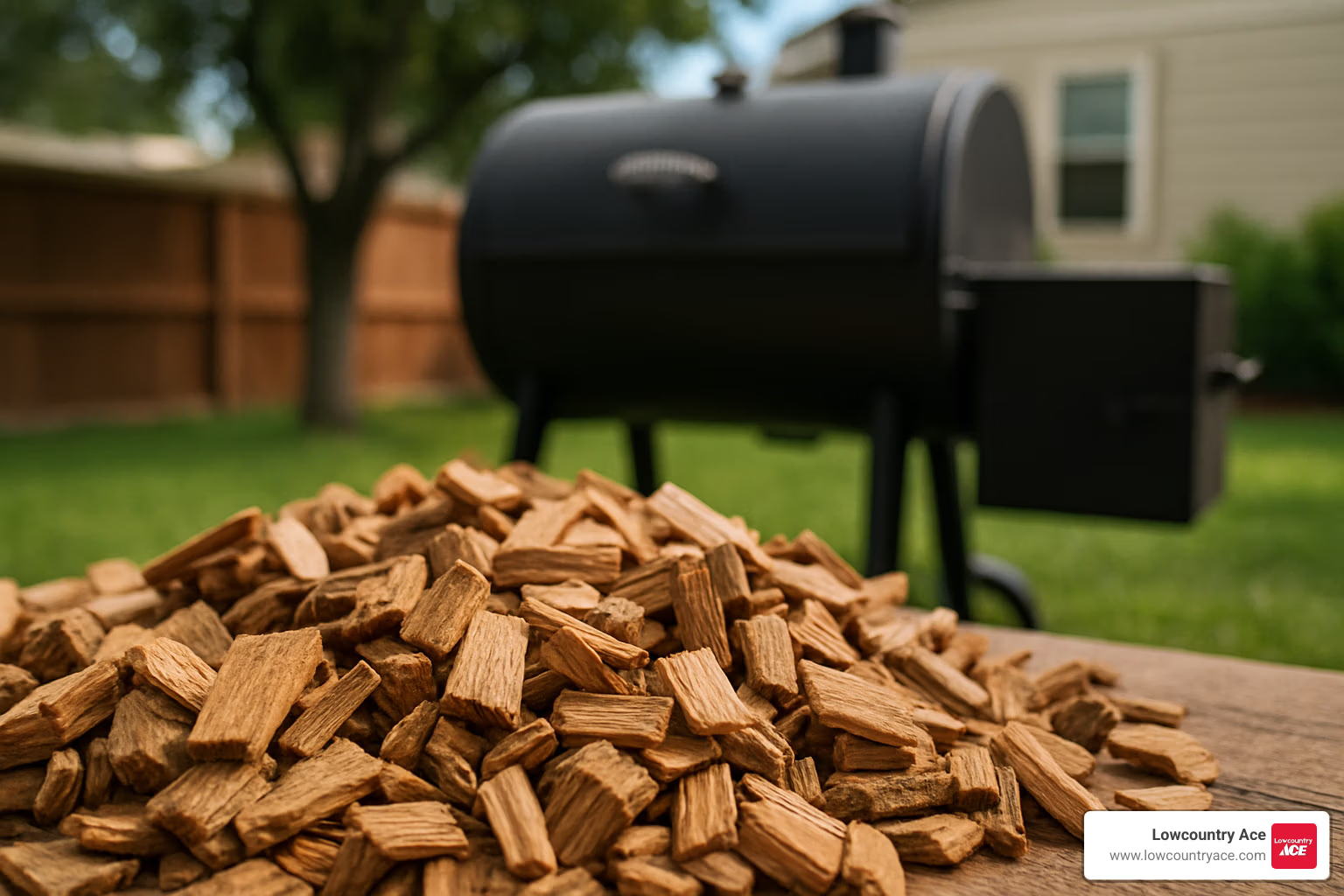Wood Chips for Smokers: 7 Powerful Tips for Perfect BBQ 2025
Why Wood Chips for Smokers Transform Your Backyard BBQ Game
Wood chips for smokers are small pieces of kiln-dried wood (typically 2-4mm in size) that create aromatic smoke to infuse your grilled and smoked foods with rich, complex flavors. Here’s what you need to know:
Quick Guide to Wood Chips for Smokers:
– Purpose: Add smoke flavor to meat, fish, vegetables, and cheese
– Size: 2-4mm pieces that burn quickly and produce steady smoke
– Usage: 1 cup of chips per 3 pounds of meat
– Popular types: Hickory (bold), Apple (mild/sweet), Cherry (fruity), Mesquite (intense)
– Best for: Gas grills, electric smokers, charcoal grills, and pellet smokers
As one BBQ enthusiast noted in our research: “Wood chips resemble spices in that their suitability varies depending on the tree species they originate from—certain types are better for fish, others for pork, and yet others for poultry.”
The science is simple but powerful. When wood chips burn, they release compounds like syringol and guaiacol that react with meat proteins and fats to create those signature smoky flavors we all crave. Different wood species produce different flavor profiles—from the mild sweetness of apple to the robust intensity of mesquite.
Whether you’re smoking your first brisket or perfecting your competition ribs, choosing the right wood chips can make or break your BBQ. The helpful team at Lowcountry Ace has guided countless Charleston-area pitmasters through their wood selection journey, helping transform weekend warriors into neighborhood BBQ legends.
Simple wood chips for smokers word guide:
– outdoor wood cooking grills
– outdoor wood smoker
What Are Wood Chips for Smokers and How Do They Work?
Think of wood chips for smokers as tiny flavor factories. These small pieces of kiln-dried wood, typically measuring 2-4 millimeters, are specially processed to create the perfect smoking experience in your backyard. Unlike regular wood scraps, these chips are dried to maintain moisture content below 13%, which means they’ll burn cleanly and produce that sweet, aromatic smoke we all love.
The magic happens through combustion science that’s actually pretty cool when you break it down. When your wood chips for smokers heat up to that sweet spot of 225-250°F, they start breaking down and releasing special compounds called syringol and guaiacol. These aren’t just fancy chemistry words—they’re the secret ingredients that give your brisket that deep, smoky flavor that makes your neighbors peek over the fence.
What makes this even more interesting is how these smoke particles work with your meat. They don’t just sit on the surface like a seasoning. Instead, they actually bond with the proteins and fats in your food, creating entirely new flavor compounds. It’s like a delicious chemistry experiment happening right on your grill. Scientific research on Maillard reaction shows how smoke compounds team up with browning reactions to build layers of complex flavors.
Quality matters here more than you might think. Good wood chips are dedusted during production, which means all the sawdust and debris gets removed. This attention to detail prevents bitter or harsh flavors from sneaking into your perfectly seasoned ribs. The helpful team at Lowcountry Ace always emphasizes choosing clean, properly processed chips—because nobody wants their BBQ tasting like an ashtray.
Smoke Generation Basics
Getting great smoke isn’t about creating huge billowing clouds that look dramatic. Actually, it’s quite the opposite. You want thin, blue smoke that’s almost invisible—this carries the clean, sweet flavors that make BBQ legendary. Those thick white clouds? They usually mean your chips are burning too hot and creating bitter compounds nobody wants to taste.
Oxygen flow controls everything. Too much air and your chips burn up fast without much smoke. Too little and they smolder dirty, creating that harsh white smoke. Most successful pitmasters learn to adjust their vents and dampers to find that perfect balance where chips burn slowly and steadily.
Heat zones are your secret weapon for consistent smoke production. Place chips directly over blazing coals and they’ll flare up and turn to ash in minutes. But position them at the cooler edges of your fire, and they’ll smolder for hours, giving you that steady stream of flavor-packed smoke that transforms ordinary meat into BBQ magic.
Flavor Profiles & Pairing Guide
Think of wood chips for smokers as the spice rack of the BBQ world—each type brings its own personality to the party. Understanding these flavor profiles is what separates weekend grillers from backyard legends who have neighbors mysteriously appearing whenever the smoker fires up.
Fruitwoods are the gentle giants of the smoking world. Apple wood delivers mild, sweet smoke that whispers rather than shouts, making it perfect for those who want smoke flavor without overwhelming their carefully seasoned meat. Cherry wood not only adds a subtle fruity sweetness but also works like nature’s food coloring, creating those gorgeous mahogany hues that make your BBQ look magazine-worthy. Peach wood brings similar mild sweetness with just a hint of stone fruit character that pairs beautifully with pork and poultry.
On the opposite end of the intensity scale, hardwoods pack serious flavor punch. Hickory is the heavyweight champion, delivering bold, bacon-like smoke that can stand toe-to-toe with the richest cuts of beef and pork. Oak provides the steady, reliable smoke that built traditional BBQ—it’s like the dependable friend who always shows up when you need them. Mesquite burns hot and intense with an earthy, almost spicy character that screams Texas BBQ, but use it sparingly unless you want your brisket to taste like a campfire.
Then there are the specialty woods that fill the middle ground perfectly. Alder offers delicate, slightly sweet smoke that’s been the secret of Pacific Northwest salmon smoking for generations. Maple provides gentle sweetness without any of the intensity issues, making it incredibly versatile for everything from vegetables to lighter meats. Pecan sits beautifully between fruitwoods and hardwoods, offering richer flavor than apple but staying much gentler than hickory.
The helpful team at Lowcountry Ace often explains wood selection using a simple intensity scale: mild fruitwoods for delicate foods, medium woods like oak and pecan for versatility, and bold hardwoods for robust meats that can handle the heat. Color impact matters too—cherry and apple add beautiful reddish tones, while hickory and oak create deeper, darker crusts.
Best Wood Chips for Smokers by Meat Type
Matching wood to meat isn’t rocket science, but getting it right makes all the difference between good BBQ and the kind that has people asking for your secrets. Beef loves bold flavors—think hickory, mesquite, oak, and pecan. These robust woods won’t back down from a thick brisket or prime rib. Hickory and mesquite bring that deep, savory punch that makes red meat sing, while oak provides steady, reliable smoke for those all-day cooks.
Pork is the most forgiving meat for wood experimentation. Apple, cherry, hickory, and maple all work beautifully with pork’s natural sweetness. Many championship pitmasters swear by apple wood for pork shoulder and ribs, claiming it creates that perfect sweet-and-smoky balance that keeps judges coming back for more. Cherry adds stunning color that makes your ribs look like they belong in a BBQ magazine.
Poultry requires a gentler touch since chicken and turkey can easily turn bitter with too much smoke. Apple, cherry, hickory (used lightly), and pecan provide just enough flavor improvement without overwhelming the meat’s delicate taste. Cherry wood is particularly magical for creating that gorgeous golden-brown skin that makes your smoked chicken irresistible.
Seafood demands the lightest approach of all. Alder, maple, and oak provide subtle improvement without masking the fish’s natural flavors. Alder has been the gold standard for salmon smoking for centuries, offering just enough smoke character to complement without competing. For vegetables, maple reigns supreme, adding gentle sweetness that brings out natural flavors without any harsh notes.
Mixing Blends Like a Pitmaster
Creating custom wood blends is where BBQ transforms from cooking to art. The secret lies in balancing strong and mild woods to build complex flavor layers that develop throughout long cooking sessions. Start with a simple 70% mild wood and 30% bold wood ratio—this gives you a foundation of gentle flavor with just enough intensity to add character.
One of the most popular competition blends combines cherry, pecan, and oak. The cherry provides sweetness and that coveted color, pecan adds subtle nuttiness, and oak delivers steady, clean smoke that burns consistently for hours. This trio creates the kind of complex flavor profile that separates backyard heroes from the competition circuit.
For those just starting their blending journey, try simple two-wood combinations first. Apple and hickory creates sweet-and-savory magic for pork, while cherry and oak provides beautiful color with reliable smoke production. Keep detailed notes about your experiments—ratios, cooking times, and results become your personal BBQ playbook for future victories.
The key to signature blends is patience and experimentation. What works for your neighbor’s setup might not work for yours, and that’s perfectly fine. Your unique combination of equipment, technique, and wood choices becomes your BBQ fingerprint—the flavor profile that has friends begging for invitations to your next cookout.
Using Wood Chips for Smokers Across Different Cooker Types
Getting the most out of your wood chips for smokers depends entirely on understanding your equipment. Each type of cooker has its own personality, and what works perfectly in an electric smoker might fall flat in a charcoal kettle. The good news? Once you master your setup, you’ll be smoking like a pro in no time.
Electric smokers are the most beginner-friendly option for wood chip smoking. These units typically feature dedicated chip trays positioned near the heating element for easy loading and consistent results. Simply fill the tray about halfway with dry chips—overfilling restricts airflow and creates that thick, bitter white smoke nobody wants. The controlled environment makes temperature management a breeze, letting you focus on perfecting your smoke flavor.
Gas grills require a bit more creativity since most don’t come with built-in smoking features. The foil pouch method works wonders here: wrap your chips in heavy-duty aluminum foil, poke several holes for smoke escape, and place the pouch directly over a lit burner. For more serious gas grill smoking, invest in a dedicated smoke box that sits on your grill grates. These reusable metal containers make the whole process much more convenient and give you better control over smoke output.
Charcoal kettles offer the most traditional smoking experience, and many pitmasters swear they produce the best flavor. You can scatter soaked chips directly onto hot coals for immediate smoke, or arrange them around the cooler edges for slower, steadier smoke production. The trick is maintaining your fire’s heat while managing chip placement—it’s part art, part science.
Pellet grills have revolutionized backyard smoking with automated temperature control, but they still benefit from supplemental wood chips for smokers used in pellet tubes. These clever devices extend smoking time and let you customize flavors beyond whatever pellets you’re burning. The helpful team at Lowcountry Ace can walk you through the best pellet tube options for your specific grill model.
Remember the one-cup-per-3-lbs rule when planning your chip usage. This ratio works across all cooker types, though you might need to adjust based on your personal taste preferences and cooking duration. Keep your optimal smoking temperature between 225-250°F regardless of which equipment you’re using.
The wet vs dry chips debate continues among BBQ enthusiasts, but here’s the practical truth: dry chips ignite faster and work better for shorter cooks, while soaked chips burn slower and provide steadier smoke for longer sessions. Experiment with both to see what works best for your cooking style and equipment.
How Much Wood Chips for Smokers Should You Use?
The meat weight ratio is your best friend when determining chip quantities. That one-cup-per-three-pounds rule isn’t just a suggestion—it’s been tested by countless backyard pitmasters and provides the perfect balance of smoke flavor without overwhelming your food.
Burn duration varies dramatically between different wood types and chip sizes. Fine chips ignite quickly and burn completely within 30-45 minutes, making them perfect for shorter cooks but requiring frequent attention during longer sessions. Larger chips or small chunks provide 1-2 hours of steady smoke per addition, which works beautifully for those all-day brisket marathons.
Refill timing becomes second nature once you understand your equipment’s rhythm. Watch for visual cues—when that thin blue smoke starts fading, it’s time to add more chips. Most experienced smokers develop an internal clock for their setup, knowing exactly when to reload without even checking.
Setup Walk-Throughs
Chip placement makes all the difference between amateur and professional results. For electric smokers, load your chip tray evenly without packing chips too tightly. Good airflow around each piece ensures clean combustion and prevents those bitter flavors that come from smoldering piles.
Airflow adjustment controls everything about your smoke quality. Most smokers feature intake and exhaust vents that regulate oxygen flow and smoke circulation. Start with both vents partially open, then fine-tune based on what you’re seeing. Too much airflow burns chips too quickly, while too little creates stale, acrid smoke that ruins your food.
The secret is creating indirect heat zones where chips smolder rather than burn aggressively. This technique produces steady, clean smoke throughout your entire cooking session. Latest research on wood usage technique demonstrates advanced placement strategies that can take your smoking game to the next level.
The helpful team at Lowcountry Ace has guided countless Charleston-area grillers through their first smoking setups. Whether you’re working with a basic kettle grill or a high-end pellet smoker, they can help you understand the nuances of your specific equipment. For more detailed information about different grill types and their smoking capabilities, check out more info about grills.
Smart Techniques & Safety Tips for Consistent Smoke
Getting the most from your wood chips for smokers starts with proper storage. Think of wood chips like fine coffee beans—they need protection from moisture and air to maintain their quality. Store your chips in airtight containers in a cool, dry place where they won’t absorb humidity from the air. When moisture content creeps above 13%, your chips will produce more steam than smoke, giving you that thick white billowing that tastes more like wet campfire than delicious BBQ.
Wood selection matters more than many beginners realize. Avoid softwoods like pine, cedar, and fir at all costs—these resin-heavy woods create bitter, potentially harmful smoke that will ruin your food and possibly make your guests sick. Stick to food-safe hardwoods and fruitwoods that have been specifically processed for smoking. The helpful team at Lowcountry Ace can guide you toward the right wood options and help you avoid the rookie mistakes that turn great meat into expensive disappointments.
Fire safety should be your top priority when working with hot equipment and combustible materials. Keep a water spray bottle within arm’s reach for controlling unexpected flare-ups and maintaining proper moisture levels in your smoker. Always wear heat-resistant gloves when handling hot chip trays or adding wood to active fires—those metal surfaces get scorching hot and can cause serious burns.
Never leave your smoker completely unattended, especially during the critical first hour when you’re building your fire and establishing your smoke. This is when most accidents happen, and it’s also when your smoke quality needs the most attention.
Some adventurous pitmasters like to experiment with soaking chips in beer, wine, or fruit juices for extra flavor layers. While the liquid itself burns off quickly, it can slow the initial ignition and extend burn time slightly. Just remember that less is often more in BBQ—you don’t want competing flavors that fight with your carefully seasoned meat. The goal is improvement, not overpowering.
The key to avoiding bitter, overpowering smoke is patience and observation. Watch for that thin blue smoke that signals perfect combustion, and don’t be tempted to add more chips just because you can’t see dramatic smoke clouds. Your nose and taste buds will thank you for the restraint.
Frequently Asked Questions about Wood Chips for Smokers
Should I soak wood chips before smoking?
The great soaking debate has sparked countless discussions among BBQ enthusiasts, and honestly, both sides have valid points. Wood chips for smokers don’t absolutely need soaking, but it can make your smoking experience more manageable and consistent.
When you soak chips for at least 30 minutes (though many pitmasters swear by 2-4 hour soaks), they burn more slowly and produce smoke for longer periods. This means fewer trips to refill your smoker box during those marathon brisket sessions. The extra moisture also helps prevent chips from flaring up and burning to ash too quickly.
The downside? Soaked chips take longer to start producing smoke since all that water needs to evaporate first. If you’re doing a quick 30-minute fish cook, dry chips give you immediate smoke. But for low-and-slow smoking where you want steady smoke for hours, soaked chips are often your friend.
Try both methods and see what works for your cooking style. There’s no BBQ police coming to check your chip-soaking technique!
Are there any woods to avoid for health or flavor reasons?
This is where safety meets flavor, and it’s crucial to get it right. Never use softwoods like pine, cedar, fir, or spruce for smoking. These woods contain high resin levels that create bitter, potentially harmful smoke that’ll ruin your food and possibly make you sick.
Also steer clear of any treated lumber, painted wood, or mystery wood from unknown sources. You never know what chemicals might be lurking in there, and your BBQ isn’t worth the risk.
Even some “safe” hardwoods can cause problems if you go overboard. Mesquite is beloved in Texas BBQ circles, but it’s incredibly intense and can turn bitter fast if you use too much. Start with small amounts of any strong wood and work your way up based on your taste preferences.
Stick to the proven winners: hickory, oak, apple, cherry, and maple. These deliver consistent, safe results that’ll make your neighbors jealous. The helpful team at Lowcountry Ace can guide you toward food-safe wood options that deliver clean, flavorful smoke every time.
What’s the difference between chips, chunks, and pellets?
Think of wood products like different tools in your BBQ toolkit—each has its perfect moment to shine. Wood chips for smokers are the quick-burning workhorses, typically lasting 30-45 minutes. They’re perfect for gas grills, shorter cooks, or when you want immediate smoke production.
Wood chunks are the marathon runners of the wood world. These larger pieces burn steadily for 1-3 hours, making them ideal for long smoking sessions on charcoal or offset smokers. If you’re smoking a pork shoulder overnight, chunks are your best friend.
Pellets are compressed sawdust designed primarily for pellet grills, but they’re also great in pellet tubes that work on any type of smoker or grill. They offer convenience and consistent burn rates, though they generally produce milder smoke than chips or chunks.
Your choice depends on what you’re cooking and how you’re cooking it. Quick grilled chicken? Chips give you that perfect flavor burst. All-day brisket? Chunks provide steady, reliable smoke. Want convenience? Pellets deliver consistent results with minimal fuss.
Many serious pitmasters keep all three types on hand because different situations call for different approaches. It’s like having multiple spices in your kitchen—variety makes everything better.
Conclusion
There’s something magical that happens when you master wood chips for smokers—suddenly, your backyard becomes the neighborhood gathering spot, and your BBQ becomes the stuff of legend. From understanding how syringol and guaiacol create those incredible flavor compounds to knowing exactly which wood pairs with your favorite cut of meat, you’ve now got the knowledge to smoke like a true pitmaster.
The beauty of smoking lies in the journey itself. Every cook teaches you something new, whether it’s how cherry wood creates that perfect mahogany color on ribs or how a blend of pecan and apple transforms an ordinary pork shoulder into something extraordinary. Start with the basics—that one cup of chips per three pounds of meat rule—then let your taste buds guide you toward your own signature blends.
Great BBQ isn’t just about the technique; it’s about bringing people together. When that thin blue smoke starts rolling and the aroma fills your yard, you’re creating more than just a meal—you’re making memories.
The helpful team at Lowcountry Ace has been part of Charleston’s BBQ community for years, helping everyone from weekend warriors to competition pitmasters find exactly what they need. Whether you’re shopping at our James Island location on Folly Road or visiting our Folly Beach store, we stock premium wood chips for smokers, quality grills, and all the accessories you need to smoke like a pro.
Ready to start your own smoking trip? Stop by either of our Charleston-area locations and let our team help you choose the perfect wood chips and equipment for your next cookout. We’re here to help you create BBQ that’ll have your neighbors asking for your secrets. More info about grills can help you find the ideal setup to begin your pitmaster journey.
Lowcountry Ace Hardware: Your one-stop shop for home improvement. We offer quality products from trusted brands and expert advice from our experienced staff. Located on James Island, visit us for tools, hardware, fishing gear, power tools, building materials, grills & smokers, electrical and plumbing supplies, and more.

















